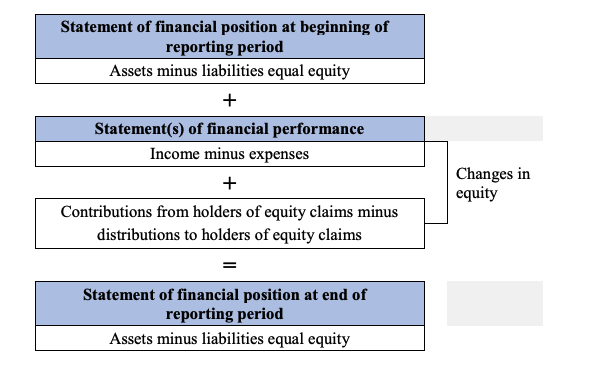In this article, we will talk about the last two components in the statement of financial position (or balance sheet) of the general purpose financial statements – liabilities and equity. In our previous article for Accounting 101 series on the Components of the general purpose financial statements, we have explained that the balance sheet is made up of assets, liabilities and equity based on the following relationship:
Assets = Liabilities + Equity
In the book-keeping activity, assets are recorded on the debit side of the book while liabilities and equity are recorded on the credit side of the book. At any point in time, the debit and the credit side of the book are balanced. You can refer to our two articles on the accounting for assets – Accounting for financial assets and Accounting for non-financial assets.
What is a liability?
From the technical perspective, liability represents a present obligation to transfer an economic resource as a result of past events. The conceptual framework for financial reporting stipulates three criteria for a liability to exist which are:
- An entity has the obligation – such that the entity has no practical ability to avoid such obligation.
- The obligation is to transfer an economic resource – such as to pay cash, to deliver goods or services or others.
- The obligation is a present obligation that exists as a result of past events.
In a layman’s term, liability represents what an entity owes to other parties. Similar to assets, the liability component can also be divided into two categories – financial liability and non-financial liability. Financial liabilities are generally governed under MFRS 9 Financial Instruments. A financial liability is defined in MFRS 132 Financial Instruments: Presentation as:
Any liability that is:
- A contractual obligation:
- To deliver cash or another financial asset to another entity; or
- To exchange financial assets or financial liabilities with another entity under conditions that are potentially unfavourable to the entity; or
- A contract that will or may be settled in the entity’s own equity instruments and is:
- a non-derivative for which the entity is or may be obliged to deliver a variable number of the entity’s own equity instruments; or
- a derivative that will or may be settled other than by the exchange of a fixed amount of cash or another financial asset for a fixed number of the entity’s own equity instruments.
A liability that does not meet the above definition is classified as a non-financial liability. Examples of non-financial liabilities are contract liability, provision and deferred revenue while examples of financial liabilities are loans and borrowings, lease liabilities, derivative liabilities, financial guarantee contracts and payables.
Recognition, derecognition and measurement of financial liabilities
Financial liabilities are recognised in the financial statements when and only when the entity becomes a party to the contractual provisions of the instrument. On its initial recognition, financial liabilities are measured at their fair value minus transaction costs that are directly attributable to the financial liabilities, if applicable. After the initial recognition, financial liabilities are generally measured or carried at amortised costs except for the following financial liabilities:
- financial liabilities at fair value through profit or loss – are subsequently measured at fair value at each reporting date.
- financial liabilities that arise when a transfer of a financial asset does not qualify for derecognition – recognise any expense incurred on the financial liability.
- financial guarantee contract by the issuers and commitments to provide a loan below a market interest rate – subsequently measured at higher of (i) the amount of the loss allowance and (ii) the amount initially recognised less cumulative amount of income recognised (if appropriate).
- contingent consideration recognised by an acquirer in a business combination – subsequently measured at fair value.
Financial liabilities should only be derecognised from the financial statements when and only when they are extinguished – i.e., when such obligations are discharged or cancelled or expire. Some considerations also need to be given to determine whether financial liabilities need to be derecognised in a situation where the borrower and lender modify the terms of debt instruments. When the terms of debt instruments are modified, modification/extinguishment gain or loss will be recognised in the financial statements.
Presentation of liabilities
Liabilities are generally presented in the statement of financial position based on the nature of the liability. Liabilities of different nature and function will not be aggregated following the presentation principles in MFRS 101 Presentation of Financial Statements unless they are immaterial. We have discussed this principle of materiality and aggregation in Considerations for the presentation of financial statements. In addition, liabilities will also be presented based on the current and non-current classification in the statement of financial position, except where an entity presents its statement of financial position based on liquidity. Liability will be classified as current when:
- an entity expects to settle the liability in its normal operating cycle;
- an entity holds the liability primarily for the purpose of trading;
- the liability is due to be settled within twelve months after the reporting period; or
- an entity does not have an unconditional right to defer settlement of the liability for at least 12 months after the reporting period.
Liabilities that do not meet any of the principles above are classified as non-current liabilities. The current classification practice may, however, be affected following the amendments made by the International Accounting Standards Board (“IASB”) on the above principles. On how the classification practice may change, we have covered this in our article – Classification of Financial Liabilities in MFRS 101: What will change?
What is equity?
Equity is defined as residual interest in the assets of the entity after deducting all its liabilities. From the relationship as illustrated above, equity is as follows:
Assets – Liabilities = Equity
Equity claims in an entity depend on the contractual rights conferred to each of the class of equity instruments issued. In some entities, different equity holders of the company have different rights to the claim of residual interest in the company. For example, a different class of shares such as common shares and preference shares gives their holders different rights to the dividends or claims on the residual interest of the company on liquidation.
In addition to the equity instruments issued by an entity to its holders, the equity component in the statements of financial position also includes movement for other transactions such as movement in the profits or loss of the company to which equity holders are entitled to, distributions to holders of an equity instrument and re-acquisition of the entity’s own equity instruments (commonly known as treasury shares). The detailed movement in the equity component is presented and explained in the statement of changes in equity, which is one of the four primary statements that an entity must prepare in a complete set of financial statements.
The accounting for equity instruments is governed under MFRS 132. Similar to the financial liabilities, an equity instrument is recognised when the entity becomes the party to the contractual provisions of the instrument. However, the equity instrument will not be re-measured subsequent to its initial recognition. When an entity issues an equity instrument or acquires its own equity instruments, the transaction costs involved for such issuance or acquisition (example: legal fees paid or professional fees paid) are accounted for as a deduction from equity provided that those costs are incremental costs directly attributable to the equity transactions.
Summary of the relationship of elements in the financial statements
This article has now concluded our discussion on the elements in the statement of financial position. The diagram below as included in the Conceptual Framework for Financial Reporting by Malaysian Accounting Standards Board (“MASB”) illustrates the overall relationship between the elements in the statement of financial position and elements in the statement of financial performance.

We will cover the discussion on the elements in the statement of financial performance in our next article. Till then don’t forget to read our other articles in Accounting 101 series and stay tuned!

